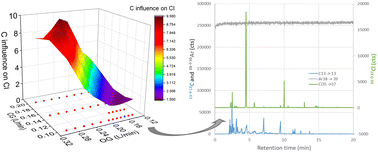Chlorine speciation in complex hydrocarbon matrices using GC-ICP-MS/MS†
Abstract
In this study, the hyphenation of gas chromatography with ICP tandem mass spectrometry (GC-ICP-MS/MS) for the analysis of volatile organochlorides in complex hydrocarbon samples is described. H2 was used as a reaction gas in the MS/MS collision reaction cell in order to bring selectivity and sensitivity towards chlorine detection and the gas flows feeding the plasma were carefully optimized to limit the interferences due to coeluting hydrocarbons. The response towards organochlorides proved to be linear, equimolar against elemental chlorine on a large dynamic range with quantification limits in the range of 30–100 μgCl L−1 per peak. This compound independent calibration (CIC) method was successfully applied to the analysis of light petroleum samples as well as plastic pyrolysis oil light cuts with a good agreement with other total elemental chlorine analysis techniques such as X-ray fluorescence, thus attesting the strength of this technique for the untargeted analysis of organochlorides in complex hydrocarbon volatile samples.



 Please wait while we load your content...
Please wait while we load your content...